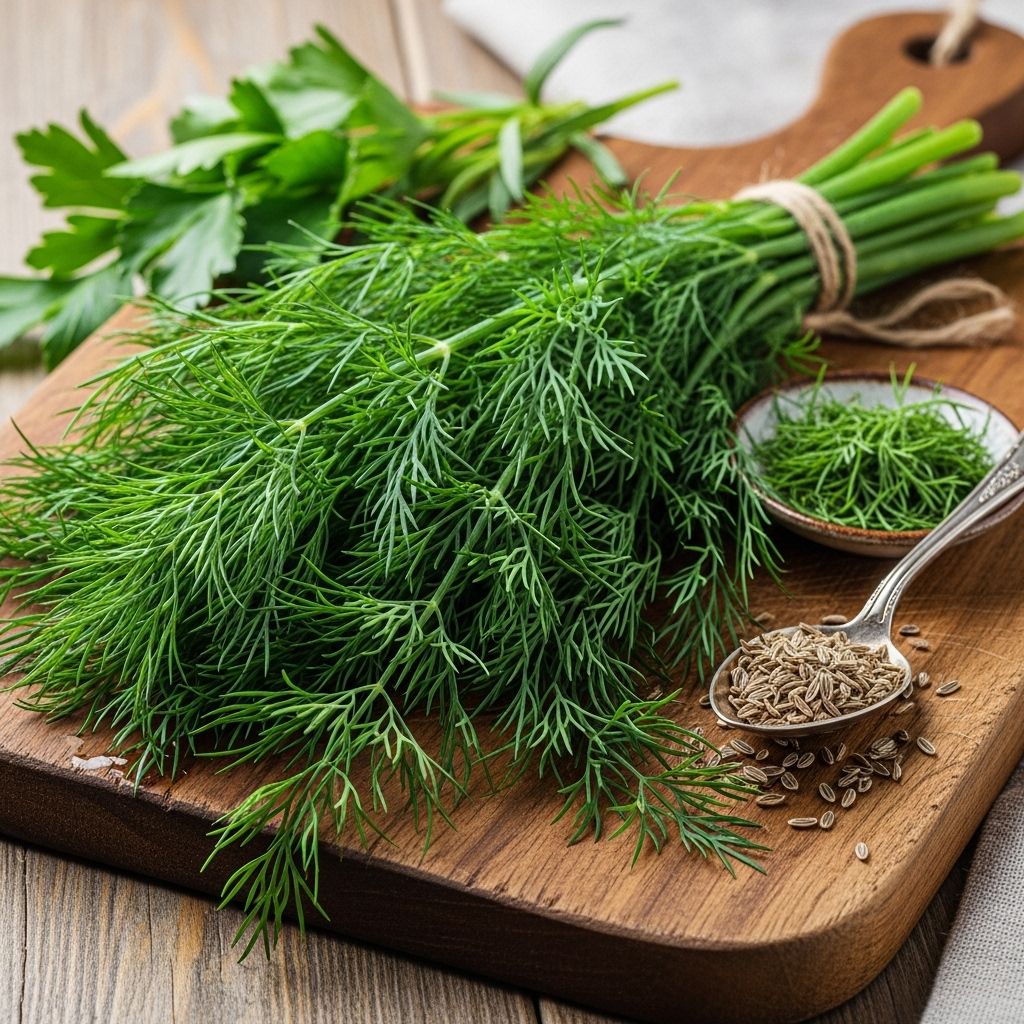Dill Leaf: Unlocking Flavor, Uses, and Easy Substitutes
Discover the versatility of dill leaf in cooking and its substitutes

Dill is a timeless herb that adds a fresh, grassy, and slightly sweet flavor to a variety of dishes. It is a key ingredient in many cuisines, particularly in Eastern European and Scandinavian cooking, where it is used to enhance the flavors of pickles, fish, salads, and soups. This article delves into the flavor profile of dill leaves, their versatile uses in cooking, and provides easy substitutes for when they are not available.
Dill Flavor Profile
Dill leaves have a
complex flavor
that is both mild and warm. Initially, they taste sweet, but as you continue to savor them, they develop into a sour, clean taste with notes of anise and caraway. These herbal notes are intertwined with hints of citrus, creating a vibrant and inviting aroma. Dill’s flavor is characterized by compounds such as carvone, limonene, and apiole, which contribute to its distinctive taste.Uses of Dill Leaves
Dill leaves are best used fresh as their delicate flavor is easily lost when dried. However, freeze-dried dill leaves can retain their flavor relatively well for a few months. They are commonly used in dishes like egg spreads, fish marinades, salads, and soups. Dill pairs well with members of its family, such as fennel, celery, and carrots. Below are some creative ways to incorporate dill leaves into your cooking:
- Fish and Seafood: Dill is a classic addition to cured salmon (gravlax) and other fish dishes where its fresh flavor complements the richness of the seafood.
- Pickles and Fermented Foods: Dill seeds are often used in pickling, but dill leaves can also be added to create a fresh, herbal flavor in pickled cucumbers or other vegetables.
- Salads and Sauces: Add fresh dill to salads for a bright, herbaceous taste. It also enhances the flavor of sauces like yogurt or sour cream-based dips.
- Herbal Teas and Infusions: Dill can be used to make a soothing herbal tea or infused water with a light, refreshing flavor.
Dill Seeds
Dill seeds have a stronger, more concentrated flavor compared to the leaves. They impart a flavor similar to caraway but with hints of anise or lemon, depending on the variety. Dill seeds are used in baking, such as in herb breads, and in pickling recipes.
Easy Substitutes for Dill Leaves
For recipes that call for dill leaves, there are several substitutes you can use if fresh dill is not available. Here are some options:
- Tarragon: This herb has a similar anise-like flavor and can be used in dishes where a slightly bitter taste is desired.
- Fennel Leaves: While stronger than dill, fennel leaves can add a similar freshness and herbal flavor to dishes.
- Basil: While basil has a distinctly different flavor profile, it can be used in some recipes as a last resort, especially in salads or sauces where a fresh, herbaceous taste is needed.
- Chervil: This herb has a delicate, slightly sweet flavor that can work well in dishes where dill is not available.
Culinary History of Dill
Dill has a rich history that spans thousands of years, with its use dating back to ancient civilizations like the Egyptians, Greeks, and Romans. It was not only valued for its culinary properties but also for its medicinal uses, such as aiding digestion and providing antioxidant benefits.
Aroma and Therapeutic Uses of Dill
Beyond its culinary applications, dill is also valued for its aroma. In aromatherapy, dill oil is believed to have calming effects and can be used in relaxation blends. Recent studies have shown that inhaling the fragrance of dill oil can have a sedative effect, reducing anxiety by altering bioelectric brain activity.
Dill in Wine Tasting
The aroma of dill is also noted in some wines, particularly in red varieties like Tempranillo, Cabernet Sauvignon, and Merlot, where it contributes to herbal or vegetal notes. In white wines, dill aromas are often accompanied by notes of other herbs like thyme in varieties such as Vermentino and Sauvignon Blanc.
Frequently Asked Questions (FAQs)
Q: Can dill be used in desserts?
A: Yes, dill seeds can be used in desserts, particularly those featuring apples, as they add a unique flavor profile.
Q: How should I store fresh dill leaves to preserve their flavor?
A: Fresh dill leaves are best stored in an airtight container in the refrigerator to maintain their freshness. They can also be frozen for later use.
Q: What are the health benefits of dill?
A: Dill is known for its potential health benefits, including aiding digestion, providing antioxidant properties, and supporting immune function.
References
- https://myfoodjobrocks.com/dill/
- https://tasterplace.shop/en-us/blogs/news/dill-aroma
- https://en.wikipedia.org/wiki/Dill
- https://basilfoodjournal.com/how-to-grow-and-prepare-dill/
- https://www.herbsociety.org/file_download/inline/0191822e-0527-4cac-afb6-99d2caab6b78
- https://www.area2farms.com/almanac/dill
- https://www.healthline.com/nutrition/dill
Read full bio of medha deb












